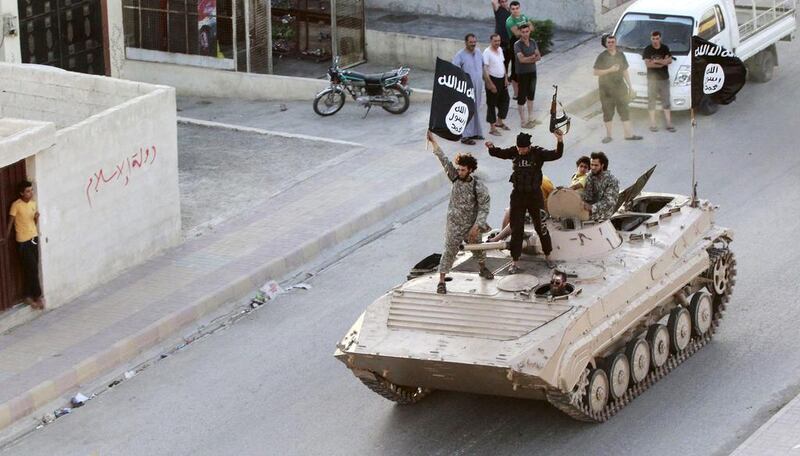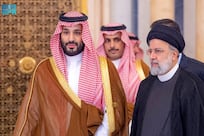In a two-part interview with Al Jazeera in May, Mohammed Al Jolani of Jabhat Al Nusra revealed that Al Qaeda’s central leadership had issued instructions against using Syria as a launch pad for attacks against the West. Although the anti-ISIL air campaign frequently struck his cells in northern Syria, Al Jolani said he was still committed to the strict orders.
Almost a year after the interview, much has changed in Syria and the wider neighbourhood. The organisation’s leadership continues to be pounded by the US-led campaign, which targeted operatives most qualified to plan and launch attacks against the West, loosely dubbed by the Americans as the “Khorassan Cell”. According to Hassan Abu Haniya, an observer of Islamist groups from Jordan, the cell’s commanders in Syria have been all but decapitated after a series of high-level killings. This has caused profound anger among Jabhat Al Nusra and Al Qaeda supporters, who started to question the current live-and-let-live strategy in Syria.
The continuing attacks against both ISIL and Al Qaeda, and their affiliates across the region, have led some sympathisers to wonder why the two jihadist groups do not collaborate. In addition to encouragement by ordinary extremist supporters, prominent jihadist ideologues offered help to narrow differences between the two groups. Abu Qatada Al Filistini from Jordan, for example, called for “management of differences” among warring jihadist and Islamist groups, while Abu Muhammed Al Maqdisi, also from Jordan, recently wrote on Twitter that he was willing to revise his position towards ISIL and join it “to spite the whole world” if it stopped labelling other jihadists as apostates.
In this vein, two American senior security analysts concluded separately last month that a merger between the two groups is possible despite persistent differences. Bruce Hoffman, who directs Georgetown University’s Center for Security Studies, predicted this could happen by 2021. Brian Jenkins, a senior adviser to Rand corporation, said the two groups have enough points of confluence to make a unified jihadist front a realistic and frightening possibility. Mr Hoffman cited a US intelligence analyst as saying such a merger would be an “absolute and unprecedented disaster” for the US government and its allies.
I put the question of whether this was possible to a long-time Al Qaeda member, who is also one of the founders of Jabhat Al Nusra in Syria, and his answer was unequivocal: “No, it’ll never happen.” Both ISIL and Al Qaeda have proven more pragmatic over the years, and it might seem plausible the two will cooperate against an enemy that is hammering them at the same time. But there are several reasons to believe the Al Qaeda member is right, and the twain of global jihadism shall not meet.
ISIL considers Al Qaeda to be “the Jews of jihad” and labels them as apostates. In doctrinal terms, striking a deal with the infidels – whether Marxist Kurds or Alawite soldiers – is more easily justifiable than a truce with apostates. Al Qaeda, on the other hand, considers ISIL to be deviant.
But assuming the two groups can overcome their ideological and operational differences in Syria, Yemen and Libya, each of the two is deeply convinced the other’s strategy is self-limiting. Even when ISIL conquered a large chunk of Iraq and Syria two years ago, Al Qaeda and its affiliates maintained that the strategy was not sustainable. They insisted that ISIL’s alienation of local, regional and international forces would only bring more destruction to the areas it controlled. Al Qaeda found itself vindicated recently as ISIL began to lose grip of its territory, including areas previously “liberated” from the Syrian regime by Jabhat Al Nusra or other forces.
Similarly, ISIL believes that Al Qaeda’s fixation with “hadhina al shaabiya”, or gradually building a support base by winning hearts and minds, is a waste of time. ISIL’s members, from top leadership to low-level associates, mock Al Qaeda’s approach as naive and impractical. Al Qaeda’s jihad is built around the idea that a vanguard of committed fighters will ultimately inspire the Muslim community as a whole to rise up and join forces with it. ISIL shares a similar idea of gradual jihad, but one that involves a perpetual war of attrition and depletion.
Both have a long view that overlooks immediate gains or losses.
The gulf between the two groups is colossal. In fact, if both of these organisations feel compelled to compromise, they still move away from each other. Since the Arab uprisings in 2011, Al Qaeda has presented itself as the “middle way” between “nationalist” jihadists who prefer a locally-focused armed struggle, such as Ahrar Al Sham in Syria, and extremist jihadists, like ISIL. Whether in Syria, Yemen or Libya, Al Qaeda will continue to move away from ISIL’s tactics, which will bring it closer to the local community and Islamist groups that could work with it. ISIL is unlikely to move closer to any of the militant groups operating in the field, or significantly moderate its tactics.
Finally, ISIL is unlikely to cooperate with Al Qaeda in the only area the two can agree: terrorist attacks abroad. ISIL’s foreign operations are modelled on Al Qaeda’s and have probably benefited from former Al Qaeda cells. By carrying out such attacks, ISIL primarily aims to develop itself as a global jihadist organisation. It is drafting its own story as a rival to Al Qaeda, and any cooperation with the latter defeats the purpose.
Apparent ideological similarities between Al Qaeda and ISIL may seem to be a reason for the two to join forces against their enemies. But, if anything, the two are only drifting further apart. There is space for both to expand in the region and internationally, without having to share their assets.
Hassan Hassan is a resident fellow at the Tahrir Institute for Middle East Policy and co-author of ISIS: Inside the Army of Terror
On Twitter: @hxhassan





